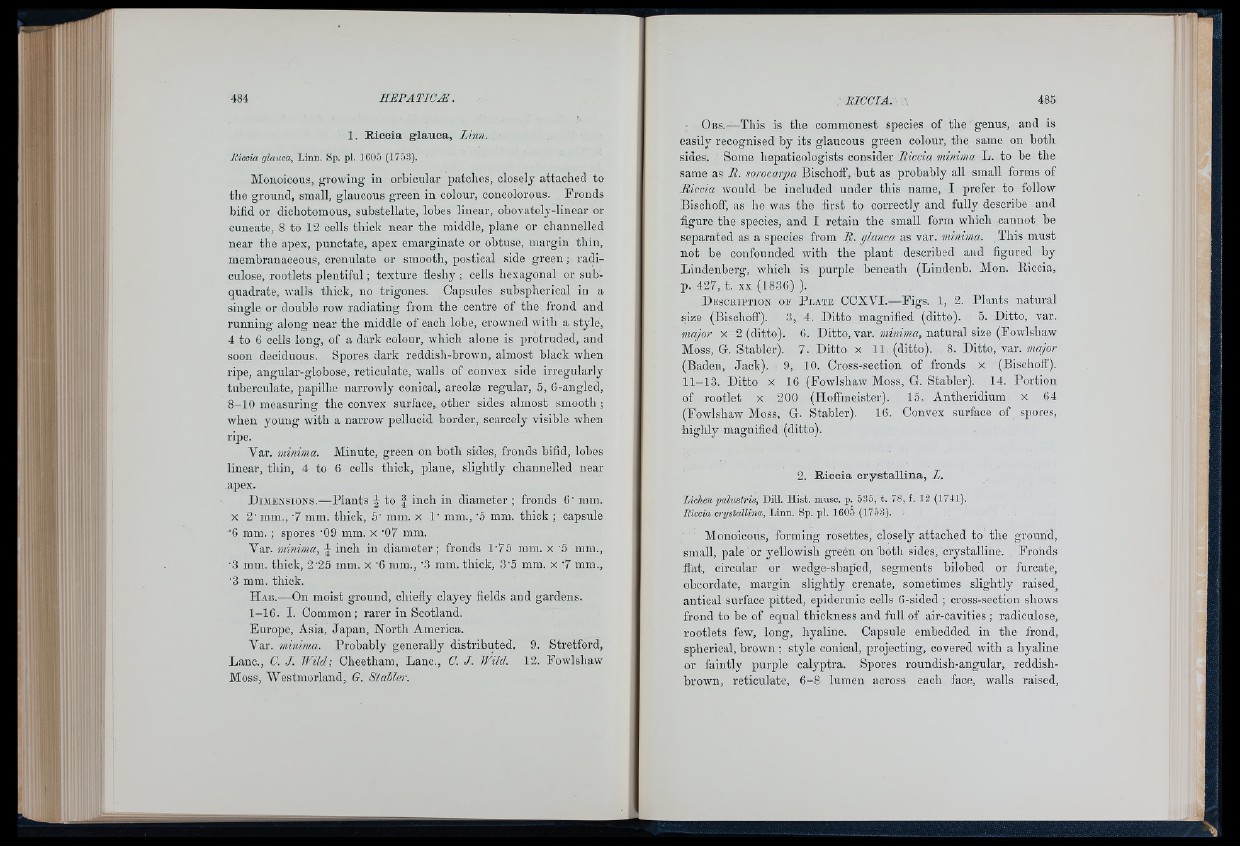
1. Eiccia glauca, Linn.
Piccia glauca, Linii. Sp. pl. ICOü (1708).
Monoicous, growing in orbicular patches, closely attached to
the ground, small, glaucous green in colour, concolorous. Fronds
bifid or dichotomous, substellate, lobes linear, obovately-linear or
cuneate, 8 to 12 cells thick near the middle, plane or channelled
near the apex, punctate, apex emarginate or obtuse, margin thin,
membranaceous, crenulate or smooth, postical side green ; radiculose,
rootlets plentiful ; texture fleshy ; cells hexagonal or subquadrate,
walls thick, no trigones. Capsules subspherical in a
single or double row radiating from the centre of the frond and
running along near the middle of each lobe, crowned with a style,
4 to C cells long, of a dark colour, which alone is protruded, and
soon deciduous. Spores dark reddish-brown, almost black when
ripe, angular-globose, reticulate, walls of convex side irregularly
tuberculate, papillæ narrowly conical, areolæ regular, 5, G-angled,
8-10 measuring the convex surface, other sides almost smooth ;
when young with a narrow pellucid border, scarcely visible when
ripe.
Var. mínima. Minute, green on both sides, fronds bifid, lobes
linear, thin, 4 to 6 cells thick, plane, slightly channelled near
apex.
D im e n s i o n s .—Plants ¿ to f inch in diameter ; fronds 6 ‘ mm.
X 2 ’ mm., 7 mm. thick, 5' mm. x 1' mm., A mm. thick ; capsule
■G mm. ; spores '09 mm. x '07 mm.
Var. minima, ¿ inch in diameter ; fronds 175 mm. x A mm.,
•3 mm. thick, 2’25 mm. x A mm., '3 mm. thick, 3A mra. x 7 mm.,
•3 mm. thick.
H a b .—On moist ground, chiefly clayey fields and gardens.
1-16. I. Common; rarer in Scotland.
Europe, Asia, Japan, North America.
Var. minima. Probably generally distributed. 9. Stretford,
Lane., C. J. Wild; Cheetham, Lane., C. J. Wild. 12. Fowlshaw
Moss, Westmorland, G. Stabler.
O bs,— This is the commonest species of the genus, and is
easily recognised by its glaucous green colour, tlie same on both
sides. Some hepaticologists consider Riccia minima L. to he the
same as ii. sorocarpa Bischoff, but as probably all small forms of
Riccia would be included under this name, I prefer to follow
Bischoff, as he was the first to correctly and fully describe and
figure the species, and I retain the small form which cannot be
separated as a species from R. glanca as var. minima. This must
not be confounded with the plant described and figured by
Lindenherg, which is purple beneath (Lindenb. Mon. Riccia,
p. 427, t. XX (1836) ).
D escription or P late CCXVI.—Figs. 1, 2. Plants natural
size (Bischoff), 3, 4. Ditto magnified (ditto). 5. Ditto, var.
major x 2 (ditto). 6, Ditto, var. »«¿«¿»¿a, natural size (Fowlsbaw
Moss, G. Stabler). 7. Ditto x 11 (ditto). 8. Ditto, var. major
(Baden, Jack). 9, 10. Cross-seotion of fronds x (Bischoff).
11-13. Ditto x 16 (Fowlshaw Moss, G. Stabler), 14. Portion
of rootlet X 200 (Hoff'meister). 15. Antheridium x 64
(Fowlshaw Moss, G. Stabler). 16, Convex surface of spores,
highly magnified (ditto).
2. Riccia cry sta llin a, L.
Lk h cn palustris. Dill, Hist. mnsc. p. 535, t. 78, t. 12 (17 + 1).
Riccia crystallina, Linn. Sp. pl. 1605 (1753).
Monoicous, forming rosettes, closely attached to the ground,
small, pale or j'ellowish green on Loth sides, crystalline. Fronds
flat, circular or wedge-shaped, segments bilobed or furcate,
obcordate, margin slightly crenate, sometimes slightly raised^
antioal surface pitted, epidermic cells G-sided ; cross-section shows
frond to be of equal thickness and full of air-cavities ; radiculose,
rootlets few, long, hyaline. Capsule embedded in the frond,
spherical, brown ; style conical, projecting, covered with a hyaline
or faintly purple calyptra. Spores roundish-angular, reddish-
brown, reticulate, 6-8 lumen across each face, walls raised,